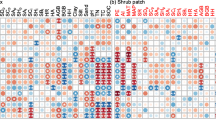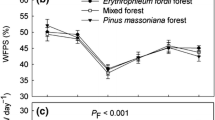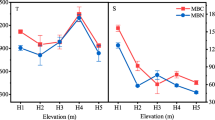Abstract
Purpose
There is a large area of coniferous plantations, such as Cunninghamia lanceolata and Pinus massoniana, in subtropics. Recent evidence has demonstrated that environmental factors and tree species mixtures have significant influences on soil organic carbon (SOC) storage in plantations. However, the diverse functional groups of SOC reveal different chemical stability. Therefore, the functional groups of SOC in subtropical plantations need to research.
Methods
The SOC functional groups analyzed by 13C nuclear magnetic resonance, and their distribution were compared among subtropical plantations from northern, middle, and southern latitudes, and between monospecific and conifer-broadleaf mixed plantations.
Results
Compared to that of the northern and middle latitude subtropical plantations, the evenness of the four SOC functional groups was higher in the southern latitude subtropical plantations. The temperature and soil bacterial α-diversity were positively correlated, and the soil fungal α-diversity was negatively correlated with the evenness of the SOC functional groups. The proportion of the recalcitrant SOC functional group (alkyl C) was higher in the conifer-broadleaf mixed plantations than in the coniferous plantations, particularly in C. lanceolata plantations. The climatic factors, soil pH and soil microbial α-diversity, rather than the functional groups of leaf litter and fine root C, led to the differences in the SOC functional groups between the monospecific and mixed plantations.
Conclusion
Our findings highlight that there is a minor risk of C decomposition in the southern subtropical plantations, and converting coniferous plantations to mixed plantations, which could improve the chemical stability of SOC in subtropical regions.









Similar content being viewed by others
Abbreviations
- A/OA:
-
Alkyl C/O-alkyl C
- Arom/OA:
-
Aromatic C/O-alkyl C
- LMM:
-
Linear mixed-effects model
- NMR:
-
Nuclear magnetic resonance
- PCR:
-
Polymerase chain reaction
- RDA:
-
Redundancy analysis
- SEM:
-
Structural equation model
- SOC:
-
Soil organic carbon
- VIF:
-
Variance inflation factor
References
Baldock J, Oades J, Waters A, Peng X, Vassallo A, Wilson M (1992) Aspects of the chemical structure of soil organic materials as revealed by solid-state 13C NMR spectroscopy. Biogeochemistry 16:1–42. https://doi.org/10.1007/BF02402261
Baldrian P (2008) Wood-inhabiting ligninolytic basidiomycetes in soils: ecology and constraints for applicability in bioremediation. Fungal Ecol 1:4–12. https://doi.org/10.1016/j.funeco.2008.02.001
Bauhus J, Forrester DI, Pretzsch H (2017) Mixed-species forests: the development of a Forest management paradigm. In: Pretzsch H, Forrester DI, Bauhus J (eds) Mixed-species forests. Springer Nature, Berlin
Berg B, Meentemeyer V (2002) Litter quality in a north European transect versus carbon storage potential. Plant Soil 242:83–92. https://doi.org/10.1023/A:1019637807021
Bian J, Hao Z, Zheng J, Ge Q, Yin Y (2013) The shift on boundary of climate regionalization in China from 1951 to 2010. Geogr Res 32:1179–1187
Bouskill NJ, Lim HC, Borglin S, Salve R, Wood TE, Silver WL, Brodie EL (2013) Pre-exposure to drought increases the resistance of tropical forest soil bacterial communities to extended drought. ISME J 7:384–394. https://doi.org/10.1038/ismej.2012.113
Buckeridge KM, Creamer C, Whitaker J (2022) Deconstructing the microbial necromass continuum to inform soil carbon sequestration. Funct Ecol. https://doi.org/10.1111/1365-2435.14014
Chen C, Xu Z, Mathers NJ (2004) Soil carbon pools in adjacent natural and plantation forests of subtropical Australia. Soil Sci Soc Am J 68:282–291. https://doi.org/10.2136/sssaj2004.2820
Chen S, Wang W, Xu W, Wang Y, Wan H, Chen D, Tang Z, Tang X, Zhou G, Xie Z, Zhou D, Shangguan Z, Huang J, He J, Wang Y, Sheng J, Tang L, Li X, Dong M et al (2018) Plant diversity enhances productivity and soil carbon storage. P Nat Acad Sci USA 115:4027–4032. https://doi.org/10.1073/pnas.1700298114
Clark JS, Iverson L, Woodall CW, Allen CD, Bell DM, Bragg DC, D'Amato AW, Davis FW, Hersh MH, Ibanez I (2016) The impacts of increasing drought on forest dynamics, structure, and biodiversity in the United States. Glob Chang Biol 22:2329–2352. https://doi.org/10.1111/gcb.13160
Cotrufo MF, Wallenstein MD, Boot CM, Denef K, Paul E (2013) The microbial efficiency-matrix stabilization (MEMS) framework integrates plant litter decomposition with soil organic matter stabilization: do labile plant inputs form stable soil organic matter? Glob Chang Biol 19:988–995. https://doi.org/10.1111/gcb.12113
Crow SE, Lajtha K, Filley TR, Swanston CW, Bowden RD, Caldwell BA (2009) Sources of plant-derived carbon and stability of organic matter in soil: implications for global change. Glob Chang Biol 15:2003–2019. https://doi.org/10.1111/j.1365-2486.2009.01850.x
Cusack DF, Halterman SM, Tanner EVJ, Wright SJ, Hockaday W, Dietterich LH, Turner BL (2018) Decadal-scale litter manipulation alters the biochemical and physical character of tropical forest soil carbon. Soil Biol Biochem 124:199–209. https://doi.org/10.1016/j.soilbio.2018.06.005
Davidson EA, Janssens IA (2006) Temperature sensitivity of soil carbon decomposition and feedbacks to climate change. Nature 440:165–173. https://doi.org/10.1038/nature04514
DeAngelis KM, Pold G, Topçuoğlu BD, van Diepen LTA, Varney RM, Blanchard JL, Melillo J, Frey SD (2015) Long-term forest soil warming alters microbial communities in temperate forest soils. Front Microbiol 6:104. https://doi.org/10.3389/fmicb.2015.00104
Dignac MF, Rumpel C (2006) Relative distributions of phenol dimers and hydroxy acids in a cultivated soil and above ground maize tissue. Org Geochem 37:1634–1638. https://doi.org/10.1016/j.orggeochem.2006.06.019
Feng X, Simpson AJ, Wilson KP, Dudley Williams D, Simpson MJ (2008) Increased cuticular carbon sequestration and lignin oxidation in response to soil warming. Nat Geosci 1:836–839. https://doi.org/10.1038/ngeo361
Funakawa S, Fujii K, Kadono A, Watanabe T, Kosaki T (2014) Could soil acidity enhance sequestration of organic carbon in soils? In: Hartemink AE, McSweeney K (eds) Soil Carbon. Springer International Publishing, Cham
Guo X, Meng M, Zhang J, Chen HYH (2016) Vegetation change impacts on soil organic carbon chemical composition in subtropical forests. Sci Rep 6:29607. https://doi.org/10.1038/srep29607
Hall SJ, Ye C, Weintraub SR, Hockaday WC (2020) Molecular trade-offs in soil organic carbon composition at continental scale. Nat Geosci 13:687–692. https://doi.org/10.1038/s41561-020-0634-x
Huang Z, Xu Z, Chen C, Boyd S (2008) Changes in soil carbon during the establishment of a hardwood plantation in subtropical Australia. Forest Ecol Manag 254:46–55. https://doi.org/10.1016/j.foreco.2007.07.021
Huang X, Liu S, You Y, Wen Y, Wang H, Wang J (2017) Microbial community and associated enzymes activity influence soil carbon chemical composition in Eucalyptus urophylla plantation with mixing N2-fixing species in subtropical China. Plant Soil 414:199–212. https://doi.org/10.1007/s11104-016-3117-5
IPCC (2021) Climate change 2021: the physical science basis. Contribution of working group I to the sixth assessment report of the intergovernmental panel on climate change. Cambridge University Press, Cambridge
ISSS–ISRIC–FAO (1998) World Reference Base for soil resources. Acco Press, Leuven
Jackson RB, Lajtha K, Crow SE, Hugelius G, Kramer MG, Piñeiro G (2017) The ecology of soil carbon: pools, vulnerabilities, and biotic and abiotic controls. Annu Rev Ecol Evol S 48:419–445. https://doi.org/10.1146/annurev-ecolsys-112414-054234
Jia Y, Zhai G, Zhu S, Liu X, Schmid B, Wang Z, Ma K, Feng X (2021) Plant and microbial pathways driving plant diversity effects on soil carbon accumulation in subtropical forest. Soil Biol Biochem 108375. https://doi.org/10.1016/j.soilbio.2021.108375
Joergensen, Georg R (2018) Amino sugars as specific indices for fungal and bacterial residues in soil. Biol Fert Soils. https://doi.org/10.1007/s00374-018-1288-3
Kelty MJ (2006) The role of species mixtures in plantation forestry. Forest Ecol Manag 233:195–204. https://doi.org/10.1016/j.foreco.2006.05.011
Kögel-Knabner I (2002) The macromolecular organic composition of plant and microbial residues as inputs to soil organic matter. Soil Biol Biochem 34:139–162. https://doi.org/10.1016/S0038-0717(01)00158-4
Koven CD, Hugelius G, Lawrence DM, Wieder WR (2017) Higher climatological temperature sensitivity of soil carbon in cold than warm climates. Nat Clim Chang 7:817–822. https://doi.org/10.1038/nclimate3421
Krishna MP, Mohan M (2017) Litter decomposition in forest ecosystems: a review. Energy Ecology and Environment 2:1–14. https://doi.org/10.1007/s40974-017-0064-9
Lefcheck JS (2016) piecewiseSEM: piecewise structural equation modelling in r for ecology, evolution, and systematics. Methods Ecol Evol. https://doi.org/10.1111/2041-210X.12512
Lehmann J, Kleber M (2015) The contentious nature of soil organic matter. Nature 528:60–68. https://doi.org/10.1038/nature16069
Lehmann J, Hansel CM, Kaiser C, Kleber M, Maher K, Manzoni S, Nunan N, Reichstein M, Schimel JP, Torn MS, Wieder WR, Kögel-Knabner I (2020) Persistence of soil organic carbon caused by functional complexity. Nat Geosci 13:529–534. https://doi.org/10.1038/s41561-020-0612-3
Li Y, Li Y, Chang SX, Liang X, Qin H, Chen J, Xu Q (2017) Linking soil fungal community structure and function to soil organic carbon chemical composition in intensively managed subtropical bamboo forests. Soil Biol Biochem 107:19–31. https://doi.org/10.1016/j.soilbio.2016.12.024
Li Y, Bruelheide H, Scholten T, Schmid B, Sun Z, Zhang N, Bu W, Liu X, Ma K (2019) Early positive effects of tree species richness on soil organic carbon accumulation in a large-scale forest biodiversity experiment. J Plant Ecol 12:882–893. https://doi.org/10.1093/jpe/rtz026
Li Y, Liu X, Xu W, Bongers FJ, Bao W, Chen B, Chen G, Guo K, Lai J, Lin D, Mi X, Tian X, Wang X, Yan JH, Yang B, Zheng Y, Ma K (2020) Effects of diversity, climate and litter on soil organic carbon storage in subtropical forests. Forest Ecol Manag 476:118479. https://doi.org/10.1016/j.foreco.2020.118479
Liang C, Amelung W, Lehmann J, Kästner M (2019) Quantitative assessment of microbial necromass contribution to soil organic matter. Glob Chang Biol 25. https://doi.org/10.1111/gcb.14781
Liu S, Wu S, Wang H (2014) Managing planted forests for multiple uses under a changing environment in China. NZ J Forestry Sci 44:S3. https://doi.org/10.1186/1179-5395-44-s1-s3
Liu X, Trogisch S, He J, Niklaus PA, Bruelheide H, Tang Z, Erfmeier A, Scherer-Lorenzen M, Pietsch KA, Yang B, Kühn P, Scholten T, Huang Y, Wang C, Staab M, Leppert KN, Wirth C, Schmid B, Ma K (2018) Tree species richness increases ecosystem carbon storage in subtropical forests. P Roy Soc B-Biol Sci 285:20181240. https://doi.org/10.1098/rspb.2018.1240
Lorenz K, Lal R, Preston CM, Nierop KGJ (2007) Strengthening the soil organic carbon pool by increasing contributions from recalcitrant aliphatic bio(macro)molecules. Geoderma 142:1–10. https://doi.org/10.1016/j.geoderma.2007.07.013
Martinez D, Challacombe J, Morgenstern I, Hibbett D, Schmoll M, Kubicek CP, Ferreira P, Ruiz-Duenas FJ, Martinez AT, Kersten P, Hammel KE, Vanden Wymelenberg A, Gaskell J, Lindquist E, Sabat G, Splinter BonDurant S, Larrondo LF, Canessa P, Vicuna R et al (2009) Genome, transcriptome, and secretome analysis of wood decay fungus Postia placenta supports unique mechanisms of lignocellulose conversion. P Nat Acad Sci USA 106:1954–1959. https://doi.org/10.1073/pnas.0809575106
Mikutta R, Kleber M, Torn MS, Jahn R (2006) Stabilization of soil organic matter: association with minerals or chemical recalcitrance? Biogeochemistry 77:25–56. https://doi.org/10.1007/s10533-005-0712-6
Miltner A, Bombach P, Schmidt-Brücken B, Kästner M (2012) SOM genesis: microbial biomass as a significant source. Biogeochemistry 111:41–55. https://doi.org/10.1007/s10533-011-9658-z
Miura T, Niswati A, Swibawa IG, Haryani S, Gunito H, Kaneko N (2013) No tillage and bagasse mulching alter fungal biomass and community structure during decomposition of sugarcane leaf litter in Lampung Province, Sumatra, Indonesia. Soil Biol Biochem 58:27–35. https://doi.org/10.1016/j.soilbio.2012.10.042
Ono K, Hiradate S, Morita S, Hirai K (2013) Fate of organic carbon during decomposition of different litter types in Japan. Biogeochemistry 112:7–21. https://doi.org/10.1007/s10533-011-9682-z
Ouyang S, Xiang W, Wang X, Xiao W, Chen L, Li S, Sun H, Deng X, Forrester DI, Zeng L, Lei P, Lei X, Gou M, Peng C (2019) Effects of stand age, richness and density on productivity in subtropical forests in China. J Ecol 107:2266–2277. https://doi.org/10.1111/1365-2745.13194
Pisani O, Frey SD, Simpson AJ, Simpson MJ (2015) Soil warming and nitrogen deposition alter soil organic matter composition at the molecular-level. Biogeochemistry 123:391–409. https://doi.org/10.1007/s10533-015-0073-8
RCoreTeam (2019) R: a language and environment for statistical computing. R Foundation for Statistical Computing. http://www.R-project.org/ Vienna, Austria
Schmidt MWI, Knicker H, Hatcher PG, Kogel-Knabner I (1997) Improvement of 13C and 15N CPMAS NMR spectra of bulk soils, particle size fractions and organic material by treatment with 10% hydrofluoric acid. Eur J Soil Sci 48:319–328. https://doi.org/10.1111/j.1365-2389.1997.tb00552.x
Schmidt MWI, Torn MS, Abiven S, Dittmar T, Guggenberger G, Janssens IA, Kleber M, Kogel-Knabner I, Lehmann J, Manning DA, Nannipieri P, Rasse DP, Weiner S, Trumbore SE (2011) Persistence of soil organic matter as an ecosystem property. Nature 478:49–56. https://doi.org/10.1038/nature10386
Shannon C, Weaver W (1949) The mathematical theory of communication. University of Illinois Press, Urbana
Simpson AJ, Simpson MJ, Smith E, Kelleher BP (2007) Microbially derived inputs to soil organic matter: are current estimates too low? Environ Sci Technol 41:8070–8076. https://doi.org/10.1021/es071217x
Slessarev EW, Lin Y, Bingham NL, Johnson JE, Dai Y, Schimel JP, Chadwick OA (2016) Water balance creates a threshold in soil pH at the global scale. Nature 540:567–569. https://doi.org/10.1038/nature20139
Spellerberg IF, Fedor PJ (2003) A tribute to Claude Shannon (1916–2001) and a plea for more rigorous use of species richness, species diversity and the 'Shannon–Wiener' index. Glob Ecol Biogeogr 12:177–179. https://doi.org/10.1046/j.1466-822X.2003.00015.x
Vogt KA, Persson H (1991) Measuring growth and development of roots. In: Lassoie JP, Hinckley TM (eds) Techniques and approaches in Forest tree ecophysiology. CRC Press, Inc., Boca Raton
Wang H, Liu S, Mo J, Wang J, Makeschin F, Wolff M (2010) Soil organic carbon stock and chemical composition in four plantations of indigenous tree species in subtropical China. Ecol Res 25:1071–1079. https://doi.org/10.1007/s11284-010-0730-2
Wang H, Liu S, Wang J, You Y, Yang Y, Shi Z, Huang X, Zheng L, Li Z, Ming A (2018) Mixed-species plantation with Pinus massoniana and Castanopsis hystrix accelerates C loss in recalcitrant coniferous litter but slows C loss in labile broadleaf litter in southern China. Forest Ecol Manag 422:207–213. https://doi.org/10.1016/j.foreco.2018.04.024
Wang H, Liu S, Schindlbacher A, Wang J, Yang Y, Song Z, You Y, Shi Z, Li Z, Chen L, Ming A, Lu L, Cai D (2019a) Experimental warming reduced topsoil carbon content and increased soil bacterial diversity in a subtropical planted forest. Soil Biol Biochem 133:155–164. https://doi.org/10.1016/j.soilbio.2019.03.004
Wang H, Liu S, Song Z, Yang Y, Wang J, You Y, Zhang X, Shi Z, Nong Y, Ming A, Lu L, Cai D (2019b) Introducing nitrogen-fixing tree species and mixing with Pinus massoniana alters and evenly distributes various chemical compositions of soil organic carbon in a planted forest in southern China. Forest Ecol Manag 449:117477. https://doi.org/10.1016/j.foreco.2019.117477
Wang B, An S, Liang C, Liu Y, Kuzyakov Y (2021) Microbial necromass as the source of soil organic carbon in global ecosystems. Soil Biol Biochem 162:108422. https://doi.org/10.1016/j.soilbio.2021.108422
Wiesmeier M, Urbanski L, Hobley E, Lang B, von Lützow M, Marin-Spiotta E, van Wesemael B, Rabot E, Ließ M, Garcia-Franco N, Wollschläger U, Vogel H-J, Kögel-Knabner I (2019) Soil organic carbon storage as a key function of soils - a review of drivers and indicators at various scales. Geoderma 333:149–162. https://doi.org/10.1016/j.geoderma.2018.07.026
Wu J, Deng Q, Hui D, Xiong X, Zhang D (2020) Reduced lignin decomposition and enhanced soil organic carbon stability by acid rain: evidence from 13C isotope and 13C NMR analyses. Forests 11:1191. https://doi.org/10.3390/f11111191
Yang Y, Xie H, Mao Z, Bao X, He H, Zhang X, Liang C (2022) Fungi determine increased soil organic carbon more than bacteria through their necromass inputs in conservation tillage croplands. Soil Biol Biochem 167:108587. https://doi.org/10.1016/j.soilbio.2022.108587
Yu G, Chen Z, Piao S, Peng C, Ciais P, Wang Q, Li X, Zhu X (2014) High carbon dioxide uptake by subtropical forest ecosystems in the east Asian monsoon region. P Nat Acad Sci USA 111:4910–4915. https://doi.org/10.1073/pnas.1317065111
Zhang Y, Yao S, Mao J, Olk DC, Cao X, Zhang B (2015) Chemical composition of organic matter in a deep soil changed with a positive priming effect due to glucose addition as investigated by 13C NMR spectroscopy. Soil Biol Biochem 85:137–144. https://doi.org/10.1016/j.soilbio.2015.03.013
Zhang Y, Zhang M, Tang L, Che R, Chen H, Blumfield T, Boyd S, Nouansyvong M, Xu Z (2018) Long-term harvest residue retention could decrease soil bacterial diversities probably due to favouring oligotrophic lineages. Microb Ecol 76:771–781. https://doi.org/10.1007/s00248-018-1162-8
Zhang X, Dai G, Ma T, Liu N, Hu H, Ma W, Zhang J-B, Wang Z, Peterse F, Feng X (2020) Links between microbial biomass and necromass components in the top- and subsoils of temperate grasslands along an aridity gradient. Geoderma 379:114623. https://doi.org/10.1016/j.geoderma.2020.114623
Zhu E, Liu T, Zhou L, Wang S, Wang X, Zhang Z, Wang Z, Bai Y, Feng X (2020) Leaching of organic carbon from grassland soils under anaerobiosis. Soil Biol Biochem 141:107684. https://doi.org/10.1016/j.soilbio.2019.107684
Zuur A, Ieno EN, Walker N, Saveliev AA, Smith GM (2009) Mixed effects models and extensions in ecology with R. Springer, New York
Acknowledgments
We thank the experimental and logistical support from Guangxi Youyiguan Forest Ecosystem Research Station. This work was supported by grants from National Natural Science Foundation of China (31971463, 31930078) and National Key R&D Program of China (2021YFD2200402).
Author information
Authors and Affiliations
Corresponding author
Ethics declarations
Conflict of interest
The authors declare that they have no competing interests.
Additional information
Responsible Editor: Zucong Cai.
Publisher’s note
Springer Nature remains neutral with regard to jurisdictional claims in published maps and institutional affiliations.
Supplementary Information
ESM 1
(DOCX 495 kb)
Rights and permissions
About this article
Cite this article
Wang, J., Wang, H., Li, X. et al. Effects of environmental factors and tree species mixtures on the functional groups of soil organic carbon across subtropical plantations in southern China. Plant Soil 480, 265–281 (2022). https://doi.org/10.1007/s11104-022-05580-5
Received:
Accepted:
Published:
Issue Date:
DOI: https://doi.org/10.1007/s11104-022-05580-5




